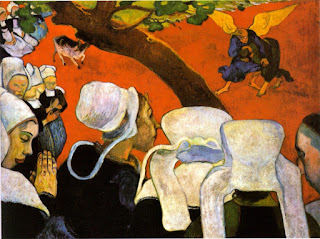 |
| Eugène Henri Paul Gauguin |
Eugène Henri Paul Gauguin (7 June 1848-8 May 1903) was a French post-Impressionist artist.
Underappreciated until after his death, Gauguin is now recognized for his experimental use of color and Synthetist style that were distinctly different from Impressionism. His work was influential to the French avant-garde and many modern artists, such as Pablo Picasso and Henri Matisse. Gauguin's art became popular after his death, partially from the efforts of art dealer Ambroise Vollard, who organized exhibitions of his work late in his career, as well as assisting in organizing two important posthumous exhibitions in Paris. Many of his paintings were in the possession of Russian collector Sergei Shchukin and other important collections.
Underappreciated until after his death, Gauguin is now recognized for his experimental use of color and Synthetist style that were distinctly different from Impressionism. His work was influential to the French avant-garde and many modern artists, such as Pablo Picasso and Henri Matisse. Gauguin's art became popular after his death, partially from the efforts of art dealer Ambroise Vollard, who organized exhibitions of his work late in his career, as well as assisting in organizing two important posthumous exhibitions in Paris. Many of his paintings were in the possession of Russian collector Sergei Shchukin and other important collections.
More information: Gauguin Gallery
He was an important figure in the Symbolist movement as a painter, sculptor, printmaker, ceramist, and writer. His bold experimentation with color led directly to the Synthetist style of modern art, while his expression of the inherent meaning of the subjects in his paintings, under the influence of the cloisonnist style, paved the way to Primitivism and the return to the pastoral. He was also an influential proponent of wood engraving and woodcuts as art forms.
 |
| Vision after the Sermon, 1888 |
Gauguin's masters were Giotto, Raphael, Ingres, Delacroix, Manet, Degas and Cézanne. His own beliefs, and in some cases the psychology behind his work, were also influenced by philosopher Schopenhauer and poet Mallarmé.
Gauguin, like some of his contemporaries such as Degas and Toulouse-Lautrec, employed a technique for painting on canvas known as peinture à l'essence. For this, the oil is drained from the paint and the remaining sludge of pigment is mixed with turpentine. He may have used a similar technique in preparing his monotypes, using paper instead of metal, as it would absorb oil giving the final images a matte appearance he desired.
He also proofed some of his existing drawings with the aid of glass, copying an underneath image onto the glass surface with watercolour or gouache for printing. Gauguin's woodcuts were no less innovative, even to the avant-garde artists responsible for the woodcut revival happening at that time. Instead of incising his blocks with the intent of making a detailed illustration, Gauguin initially chiseled his blocks in a manner similar to wood sculpture, followed by finer tools to create detail and tonality within his bold contours. Many of his tools and techniques were considered experimental. This methodology and use of space ran parallel to his painting of flat, decorative reliefs.
More information: Musée d'Orsay
Art requires philosophy, just as philosophy requires art.
Otherwise, what would become of beauty?
Paul Gauguin
No comments:
Post a Comment